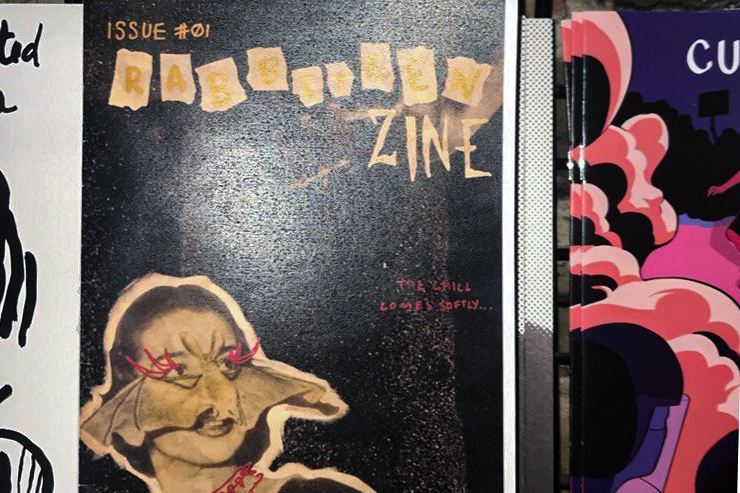Rabbiteen zine cultivates dark-alternative scene
Photo courtesy of Mila Matejcek
The cover of the zine, Rabbiteen, displayed with other zines and comics in Quimby’s, a Chicago bookstore. Rabbiteen centers around the “dark alternative” subculture in music, visual arts, and more.
January 21, 2022
Urbana’s rich music scene and indie-adjacent crowd revel in its juxtaposition to the more preppy, collegial Champaign crowd. House-shows, DIY bands and art shows play into Urbana’s rich and artistic culture. The typical house-show lineup consists of a few indie-rock bands with the occasional punk or hip-hop group mixed in.
With Urbana’s artistic lifestyle in mind, Mila Matejcek, sophomore in FAA, and Katia Janes, senior in FAA, wanted to cultivate something a little darker for Champaign-Urbana.
The two met in a Spanish class last year and immediately bonded over their interest in alternative music, fashion and aesthetics. They also laminated about how they wished they knew more alternative people in the area.
Matejcek and Janes formed an alternative club. But they wished to expand beyond the campus area and connect with alternative people from Chicago and other cities.
Their solution was to start a zine. They aimed for a small-circulation, self-published work centering around a certain topic. Thus, Rabbitteen was created.
Get The Daily Illini in your inbox!
Rabbitteen is a zine focusing on the “dark-alternative” subculture, including music, writing, fashion and visual arts.
To Matejcek and Janes, “dark-alternative” doesn’t have a fixed meaning but is instead a catch-all for goth, grunge, alternative and DIY folks alike.
“Dark-alternatives apply to the spooky people,” Matejcek said. “Metal, ‘80s, trad-type stuff. Black-clad, lots of eyeliner. But you don’t need to look anyone certain way, it’s more about the spirit.”
The name Rabbiteen hails from the title of a Jack Off Jill song, one of Matejcek’s favorite bands. Further inspiration for Rabbiteen comes from Riot grrrl – an underground feminist punk movement associated with the Pacific Northwest – and its associate zines.
Matejcek and Janes put out a call for submissions early in December, accepting anything relating to the broader umbrella of dark-alternative. As a newly-established student-run publication, the two didn’t expect to get many submissions. However, they thought wrong; the amount of interest they received surprised them.
“We got more (submissions) than we thought we were going to,” Janes said. “I thought it was going to be sparse, that we might get like five or so submissions, but there were actually a lot of people interested. That’s another reason we started the zine – we think there are a lot of darker, alternative people in the area, but they just don’t really have anything to congregate around.”
Over winter break, Matejcek and Janes put together Rabbiteen’s first issue. Limited editions of the first issue were distributed in Quimby’s, a Chicago bookstore that specializes in zines. Eventually. they plan to distribute more copies on campus once the University’s printing facilities are open for students.
Matejcek and Janes’ working styles compliment each other. Matejcek, the resident extrovert of the duo, handles scheduling and conducting band interviews. For example, Matejcek interviewed the Urbana-based gloom-rock band Pumpkin Candle for Rabbiteen’s first issue, and the Chicago-based electric-punk outfit Divisor for Rabbiteen’s upcoming second issue.
Janes, fluent with graphic design experience, takes the lead on the zine’s visuals.
“In terms of putting the pages together, it was a lot of work, but getting all the people together for interviews is a lot harder work than setting all the visuals up,” Janes said. “Getting the visuals together is just a three-to-four hour-long art sesh, and then it’s knocked out.”
Looking into the future, Matejcek and Janes hope to keep the publication running, print more physical copies and hopefully branch out into holding live events if the COVID-19 situation allows for it.
“Just to keep up with it would be pretty cool, to make sure we’re on top of it because it is kind of a big undertaking,” Matejcek said. “It would be sick if we could do any kind of live performance, but that’s kind of a pretty big goal I’m throwing out. Physical events would be sick.”
Matejcek and Janes are currently accepting submissions for upcoming issues, and can be found on Instagram at their page @rabbiteenmag.







